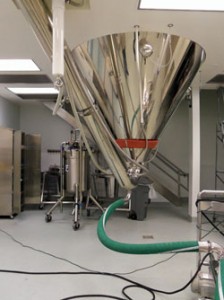According to Batycky, the goal is for patients who feel like they are going into an OFF state to take an inhalation and come right back ON: “It’s exciting because the feedback at the clinic, watching these patients, it’s pretty interesting to see this have an effect. Inhalation of this molecule is really addressing something that can’t be addressed by any other means.”
One of the aims of the current Phase 2b study is to determine the ability of patients in an OFF state to inhale a dose and to manipulate the device. Patients have been given the inhaler and some capsules to take home, allowing them to manage their own off states, and feedback has so far been good.
The patients in the study are using a larger version of the ARCUS inhaler because Civitas found that Parkinson’s patients had a hard time manipulating the smaller version. Civitas wants to be sure, Batcky says, to avoid the problems faced by MannKind after a switch in devices relatively late in the development process.

Civitas is readying its manufacturing facility for commercial production
“That’s one of the reasons we’re in this facility, and we’re already starting to bring up our large scale spray drying. We’re getting to the commercial device, getting to the commercial scale prior to our pivotals,” he says.
The company is in the process of re-commissioning the production facility, which will provide all the material for the late stage trials. The Chelsea facility also has the full testing capabilities, including stability chambers, allowing Civitas to perform all necessary analyses in house.
In recent months, the company has also announced new top management with experience in late stage development and commercialization, naming former MAP Pharmaceuticals CEO Timothy Nelson as chairman of the board and former Sunovion CEO Mark Iwicki as President and CEO.
With CVT-301 in Phase 2b, the company is looking at other molecules – “not just in terms of looking at the standard stuff for respiratory, but looking to identify indications or molecules that haven’t been thought about and that the technology would be able to fulfill,” according to Batycky; “There are an incredible number of diseases and indications out there that maybe an inhalation product hasn’t been thought about at first.”
On the subject of inhaled insulin, he notes, “Well, we have all the stuff here. We’ll see how MannKind does, right? It will be interesting to see if there’s still a perception in the field that dogs them, or challenges either perceived or real resulting from what Exubera did to the market.”
He cites the need to provide a benefit independent of the delivery route, something that injectable insulin is not doing or cannot do, to overcome the economic hurdles associated with inhaled insulin. “Having to deliver additional insulin for the inhaled dosage form to get the same therapeutic effect without any benefit in terms of safety or efficacy is problematic and will always present a challenge for macromolecules for systemic therapy.”
Civitas, Batycky says, has identified five or six molecules where rapid onset or CNS targeting are important, or for some of the less common lung diseases, as its top contenders. In the meantime, the company is focused on hiring and preparing the facility in order to produce all of the CVT-301 necessary for Phase 3 studies and beyond.
Any success in inhaled delivery of systemic drugs will be a benefit to the entire industry, he suggests: “The respiratory field still feels very small to me, so we’re still all sort of paddling in the same direction and wanting each other to succeed; that’s a good thing.”


